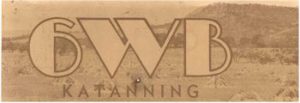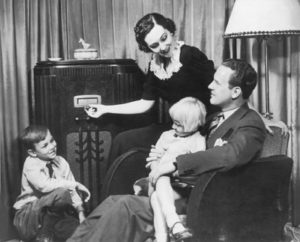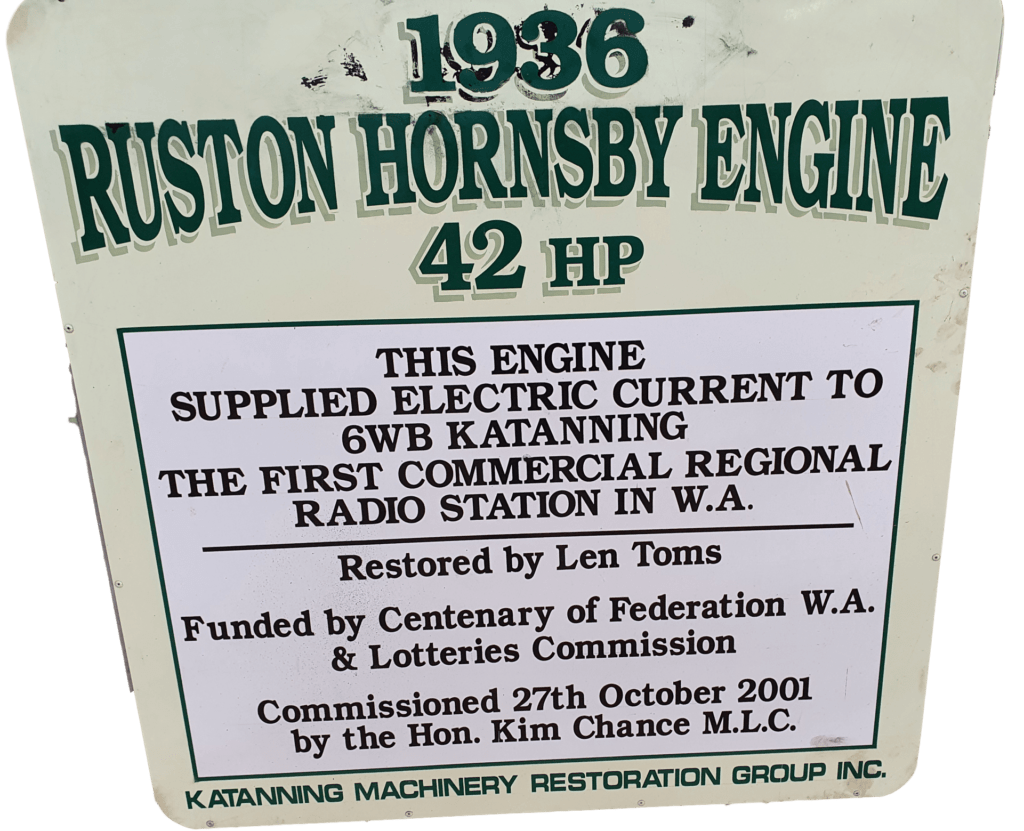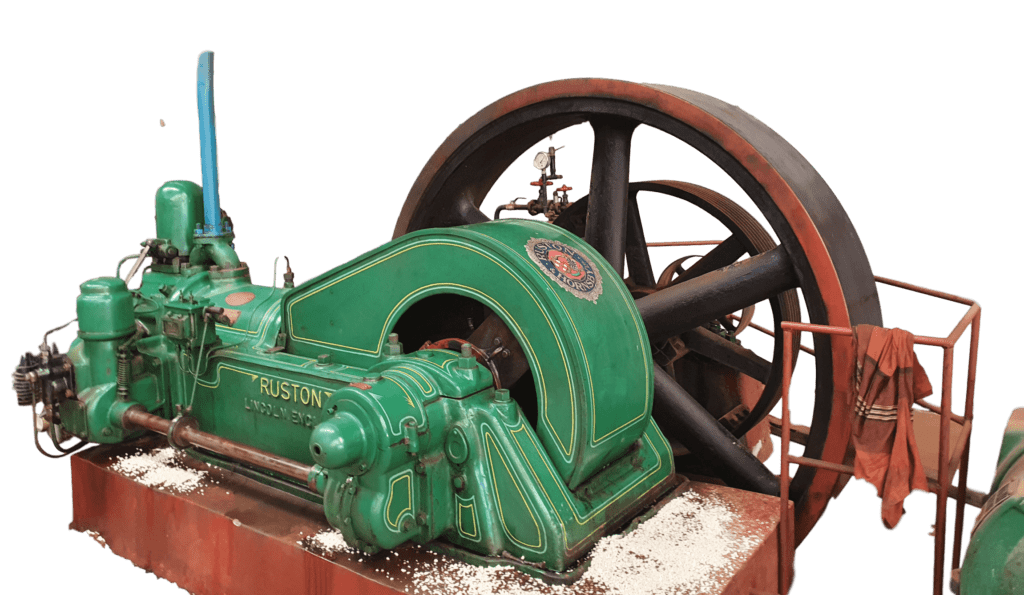Radio Station 6WB radio station 6wb radio station 6wb radio station 6wb radio station 6wb radio station 6w
Radio station 6WB has been a part of the Katanning community since it started broadcasting on Saturday 26 September, 1936. Built for W.A. Broadcasters in Perth, it was to initially operate as a relay station for 6IX in Perth. A sister station, 6MD in Merrredin, was constructed around the same time. Over the intervening years the station has seen many owners and it is currently part of the Triple M network.
When originally constructed on Tuck Road (now Sirl Road) besides the two 130 foot wooden transmitting masts it had a transmitter room and studio in one building, its own power house and a house for the engineer and his family. A new, taller metal mast was constructed in January, 1945 and the house was demolished in 2017.
This 1936 Ruston Hornsby engine was used to supply electric power to local radio station 6WB.
It was removed and restored by Len Toms at the Katanning Machinery Restoration Group.
During its time it has resident announcers and its own programming which varied in the number of hours on air. It provided a vital link to the community in times of crisis and was extremely useful when Cyclone Alby struck the south west corner of the state including Katanning. A few years back when Arthur Todd was station manager 6WB again had its own breakfast programme which was on-air from 6.00 to 9.00 am weekdays however, it is once again just a relay station to 6TZ in Bunbury.
Naturally, an important event for a country town like the addition of a radio station was well covered by the local newspapers of the day including the Great Southern Herald and the Southern Districts Advocate as well as by city newspapers with a state-wide circulation.
NEWS REPORTS
NEW RADIO STATION
OFFICIAL OPENING OF 6WB
Serving Country Listeners
Western Mail
1 October 1936

Broadcasting station 6WB, Katanning, the new B class station which has been erected for W.A. Broadcasters, Ltd. was on the air for the first time on Saturday night. The station will be used primarily as a relay station for 6IX and the whole of Saturday night’s programme, which lasted from 6 o’clock until midnight, was broadcast by both stations. The official opening ceremony was performed by the chairman of directors of W.A. Broadcasters. Ltd., Mr. H. B. Jackson, and he was supported by the chairman of the Katanning Road Board, Mr. A. Prosser and Mr. A. F. Watts. M.L.A. The new station broadcasts on a wavelength of 1,070 kilocycles (280.3 metres) and has a power of 2,000 watts.
In addressing listeners. Mr. Jackson said that the position of 6WB had been chosen and its power had been installed for the purpose mainly of benefiting the country listeners in Western Australia who. owing to geographical and other disabilities, were not always able to obtain the best results from metropolitan stations. The new station would be used primarily as a relay station for 6IX. It would not, however, be slavishly confined to the programmes of that station, but would include, as far as possible, matters of special interest to country residents, and would give its own programmes on desirable occasions.
“It is essentially a West Australian undertaking,” continued Mr. Jackson. “No person, firm or company outside Western Australia has any voice or control in its management or direction, nor does any person, firm or company outside Western Australia hold a single share in the company which owns it, namely W.A. Broadcasters, Ltd.
The Public’s Tastes.
“We shall strive to give satisfaction and benefit to the vast majority for whose benefit the station has been erected. “Tastes differ so much that it is, of course, impossible to please all listeners all the time. The programme maker’s lot, like the policeman’s, is not a happy one. He has, indeed, a very hard task and deserves much sympathy. Some people want classical music, and some want jazz; some want crooners and some want singers; some want to hear about gallopers and some about trotters; some want to hear brass bands and some want to hear election candidates, though some, it must be admitted (and sometimes justifiably) can hardly tell the difference between the two; some want to hear politicians (which university professors think strange) and some want to hear university professors (which politicians think stranger).
“With such different tastes and much different material we can only, as I said before, do our best. We welcome criticism and would especially be pleased to receive information as to reception by listeners in far distant centres.
“We live in an age of miracles. Some people doubt the miracles recorded in the Scripture. I wonder what people of long ago would have thought of the miracles of modern science had they been told them? Now we have television added to wireless, and who knows but that you listeners may live to see such a perfection of both radio and television that you will be able to sit in an armchair at home and hear all the sounds and witness all the colour and pageantry of a Coronation without the necessity of attending it in person? And who knows, but what that will be the next great improvement to reach you through this new station 6WB?”
Country Radio Reception.
“It gives me a great deal of pleasure to be able to support Mr. Jackson in declaring this station open,” said Mr. Prosser. “As chairman of the Katanning Road Board, In whose territory 6WB has been established, I feel it a great honour to be able to speak on behalf of Katanning and the surrounding districts.
W.A. Broadcasters, Ltd., deserves a lot of praise for the enterprising manner in which it has endeavoured to overcome the disadvantages that are suffered by listeners east of the Darling Ranges. It has erected one of the finest B class stations in the Commonwealth within the Katanning district. Up to the present time radio reception from metropolitan stations has been very poor, but now, with the erection of 6WB radio reception ls going to improve, not only in our district, but in all parts of the State east of the Darling Ranges.”
“No-one knows better than I do,” said Mr. Watts, “how much the people in the country districts have suffered in recent years through the absence of a suitable broadcasting station on the eastern side of the Darling Ranges. In the summer months we have not been able to obtain satisfactory reception at any time of the day, and at other times of the year the evening has been the only time when we could get a satisfactory reception. Now we have a broadcasting station in my own electorate, and it is something which has been needed for a very long time. It has been erected through the courage and enterprise of W.A. Broadcasters, Ltd., and I would like to join with Mr. Prosser in congratulating the company on that enterprise.”

Radio 6IX Perth was officially opened in 1934.
(Photos: http://watvhistory.com)
6WB Opens
W.A. BROADCASTERS’ NEW RELAY STATION AT KATANNING
Great Southern Herald
3 October 1936
After months of feverish preparation and endless trying out of new equipment, W.A. Broadcasters’ new relay station, 6WB Katanning, came on the air for the first time, officially, last Saturday night. During the previous week 6WB, while testing, was heard by many in the district, and this heightened the already intense interest shown in the construction of an essentially country listeners’ station.
The station will be used primarily as a relay station for 6IX and the whole of Saturday night’s programme, which lasted front 6 o’clock until midnight, was broadcast by both stations. The official opening ceremony was performed by the chairman of directors of W.A. Broadcasters, Ltd., Mr. H. B. Jackson, and he was supported by the chairman of the Katanning Road Board, Mr. A. Prosser, and Mr. A. F. Watts, M.L.A. The new station broadcasts on a wavelength of 1,070 kilocycles (280.3metres) and has a power of 2,000 watts.
In addressing listeners, Mr. Jackson said that the position of 6WB had been chosen and its power had been installed for the purpose mainly of benefiting the country listeners in Western Australia who, owing to geographical and other disabilities, were not always able to obtain the best results from metropolitan stations. The new station would be used primarily as a relay station for 6IX. It would not, however, be slavishly confined to the programmes of that station, but would include, as far as possible, matters of special interest to country residents, and would give its own programmes on desirable occasions.
Country Radio Reception.
“It gives me a great deal of pleasure to be able to support Mr. Jackson in declaring this station open,” said Mr. Prosser. “As chairman of the Katanning Road Board, in whose territory 6WB has been established, I feel it a great honour to be able to speak on behalf of Katanning and the surrounding districts. W.A. Broadcasters, Ltd., deserves a lot of praise for the enterprising manner in which it has endeavoured to overcome the disadvantages that are suffered by listeners east of the Darling Ranges.
It has erected one of the finest B class stations in the Commonwealth within the Katanning district. Up to the present time radio reception from metropolitan stations has very poor but now, with the erection of 6WB, radio reception is going to improve, not only in our district, but in all parts of the State cast of the Darling Ranges.”

TECHNICAL DESCRIPTION
CONSTRUCTION DETAILS
Station 6WB is situated off the Katanning-Moojebing road, and the two 130ft. wooden masts standing back from the road form a good landmark for the station. The station buildings consist of a residence, the transmitter building, and the power house.
Much preparatory work was done in September 1935, when three men and two cars toured the Katanning district searching for a suitable site. A transmitter was set up in one car and transmissions made from sites selected from ground testing, while the second car measured the intensity of the signal at given distances in certain directions front the transmitter. A number of good sites were tentatively selected in this way, and their possibilities examined from a point of view of transport, telephone facilities, etc., and then final choice made and approved by the Radio Inspector’s Department.
Most of the actual building of the transmitter was done at Newspaper House, Perth, so that the buildings at Katanning could be erected and the 130ft. masts put up while work was going on at the transmitter. The transmitter was sent from Perth to Katanning in two sections, two men installing the first section at Katanning while two others were working on the remaining portion in Perth.
In the power house there is a 40 h.p. oil engine which provides the power for turning the 26-kilowatt alternator. This machine supplies alternating current at wave is necessarily direct current if a hum-free transmission is desired, and to achieve this four rectifiers are in use
at 6WB.
The crystal oscillator is a small receiving valve and it generates the high frequency current which alternates, or changes it potential, 1,070,000 times a second. This current, although very small at first, is amplified by a succession of valves and made larger and larger until it is finally delivered from the water-cooled valve as 2,000 watts of radio frequency power and passed along the feeder lines to the aerial system. At a selected position in the amplifying procedure, the audio-frequency currents which have been generated by the microphones and pick-ups and amplified by speech amplifiers and power amplifiers, are superimposed on the radio frequency power, which is then said to be modulated.
The audio currents, which arc generated at the Perth studios, are sent to Katanning on a pair of telephone wires made available by the Postmaster General’s Department. As considerable power is absorbed by loss in the wires, it must be further strengthened on its arrival at Katanning. The telephone wires end in a studio which has been built to provide facilities for putting a programme over in the event of a fault developing in the programme line from Perth. The studio contains a microphone and magnetic pick-up and an electric turn-table motor, with sufficient records to keep a programme going for many hours.
Two engineers will be stationed at Katanning. The engineer in charge will live at the station in the residence erected by the company, and the second engineer will live at Katanning.
6WB
NEW MAST INSTALLED
Great Southern Herald
20 January 1945
Everybody has seen on the screen pictures of men climbing: up and down the exterior of buildings and standing on parapets high above ground level and otherwise emulating the exploits of common house fly. We have enjoyed the sensation of height, or we have not. according to our individual makeup, but most of us are in agreement that the pictures are at least thrilling. Well, for the past week or so it was possible to see these feats of climb and balance in the flesh very close to home, during the construction of the new aerial mast at the wireless station of 6WB. Without going into a mass of technicalities, the new mast is, 230 feet in height, is constructed in the form of a rectangular pillar of light angle steel, braced and cross braced to give it tensile strength, and is tapered off to a blunt point which rests on a block of porcelain, just like a huge upended square-sided pencil. To watch the erection was even more thrilling than the pictures could be.
The construction was carried out by Gordon Thompson, of Sidney Williams Ltd., who was assisted in the air by Mervyn Conning, and on the ground by Mr Harry Conning, Mervyn’s father, with extra help from Tom Garstone, Mr Cyril Garstone’s boy, who helped on the ground, spending as much time as he could up the mast. The 230 feet structure was erected in ten days, being mounted on a five-ton concrete block which had been previously constructed in situ.
To the people that have seen the 650-foot mast of 6WA and have attempted to count the number of guys that support it, it will come as a surprise to learn that this mast has only four guys, one at each corner of the mast, 115 feet up. They are affixed to four 7-ton blocks embedded in the ground. The mast itself was built up piece by piece, each piece of angle steel being numbered and lettered so that it would go in its right position.
When the mast was about one hundred feet high, the heaviest lengths of metal were mounted, and two men were needed on the ground to hoist them up. Once up to the top of the mast each length was placed in position and was bolted there. Other lengths followed and in a remarkably short space of time were bolted in place as were the side and cross braces, and that fifteen-foot section was completed. At this height the mast was not so very awe-inspiring, and you could hear what the rigger said when he shouted from the top. Later on, when the mast was over 200 feet high, you had to watch the construction from a distance of about 200 feet or else suffer from a stiff neck.
At that height the lengths were somewhat lighter and only one man was needed to haul them up. There was a slight wind blowing on ground level, and when the hauling started the rope bellied out until the length of steel was some 30 feet from the mast. As it got higher, however, the wind became stronger and by the time the length was approaching the top it was standing straight out from the rope like a ribbon. This one fact will give some idea of the conditions under which Thompson and the boy were working, yet they appeared to be enjoying themselves.
It is interesting to note that Mervyn Conning, who most probably had never previously had been higher from the ground than he could climb bird-nesting, has taken to this type of work so efficiently that he is to accompany Gordon Thompson to Merredin, where they will paint a similar mast for 6MD, WA Broadcaster’s relay station at that centre,
Mr Harry Simmons, Chief Engineer of WA Broadcasters Ltd., is now in Katanning, working with Mr George Sirl, manager of 6WB, on the construction of the feeder line from the transmitter at the station, to the mast. In due course the mast will be in operation and local listeners will then obtain even better reception than under existing conditions, and a wider circle of listeners in the outlying districts will be able to receive the station programmes.
Mr J. Doggett, of Amalgamated Wireless Australia, is in Katanning at present to inspect the mast before it is finally handed over to W.A, Broadcasters. The mast will be under test this weekend, and if the tests are satisfactory, it will be in use as from then. There are still certain parts to arrive from A.W.A, before the electrical side of the mast construction is completed.
It is interesting to note, that since a certain type of cable ‘coaxial’ for use on the feeder line was unobtainable owing to defence demands, the 6WB engineers substituted for it using water piping as the outside of the cable.
6IX Photos sourced from
West Australian Television History/
Radio
West Australian Country Commercial Radio Stations
Associated with the Radio West Triple M Network
Start Dates
- 6KG 981 kHz, 2 kW Kalgoorlie commenced 1931
- 6AM 864 kHz, 2 kW Northam commenced 1934
- 6WB 1071 kHz, 2 kW Katanning commenced 1936
- 6TZ 963 kHz, 2 kW Bunbury commenced 1939
- 6MD 1098 kHz, 2 kW Merredin commenced 1941
- 6CI 1134 kHz, 2 kW Collie commenced 1947
- 6NA 918 kHz, 2 kW Narrogin commenced 1951
- 6BY 900 kHz, 2 kW Bridgetown commenced 1953
- 6VA 783 kHz, 2 kW Albany commenced 1956
- 6SE 747 kHz, 5 kW Esperance commenced 1982
- 6TZ 756 kHz, 2 kW Busselton commenced 1995
MORE READING
The History of Australian Radio
A Short History of Australian Radio
radio station 6wb radio station 6wb radio station 6wb radio station 6wb radio station 6wb radio station 6wb
radio station 6wb radio station 6wb radio station 6wb radio station 6wb radio station 6wb radio station 6wb



